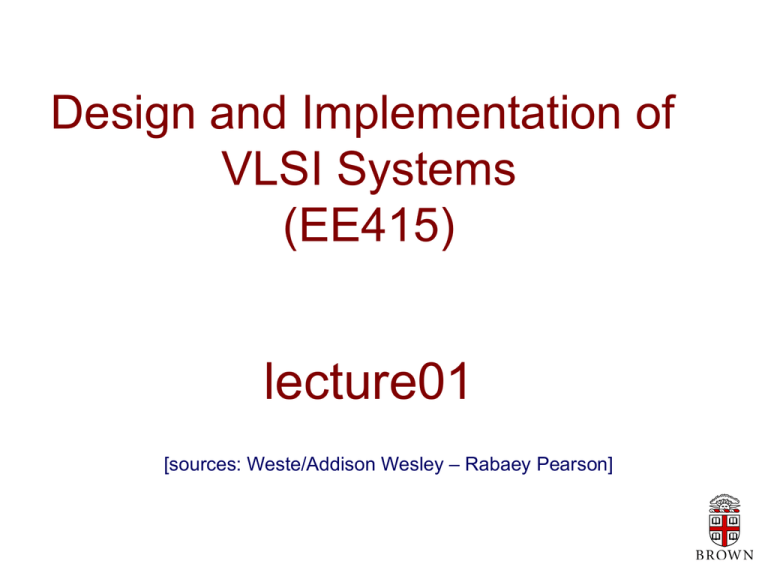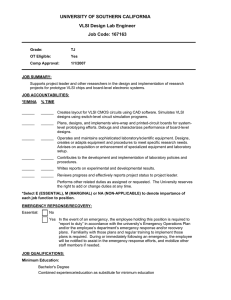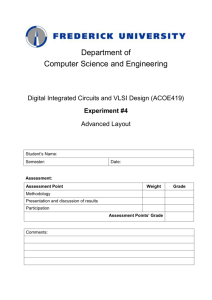lecture01 Design and Implementation of VLSI Systems (EE415)
advertisement

Design and Implementation of VLSI Systems (EE415) lecture01 [sources: Weste/Addison Wesley – Rabaey Pearson] Lecture 01: the big picture • Introduction • Brief Tour of VLSI Design and Implementation • Class logistics Objectives of the class • A VLSI (Very Large Scale Integration) system integrates millions of “electronic components” in a small area (few mm2 few cm2). • Class objective: Learn how to design “efficient” VLSI systems that implement required functionalities. • What are the design metrics? • Circuit Speed / Performance • Power consumption • Design Area • Yield What are VLSI systems composed of? 1.Transistors 2. Wires nMOS = + design pMOS Circuits CMOS logic gates How does an IC look like from the inside? wires transistors R. Noyce J. Kilby Technology scaling If a pond lily doubles everyday and it takes 30 days to completely cover a pond, on what day will the pond be 1/2 covered? Moore’s Law. The number of transistors in an integrated circuit doubles every 2 years. Quad core from Intel: ~600 million transistors in 286 mm2 Feature sizes Human Hair ~75 m . . 0.18 m 180 nm feature ~40,000 (65-nm node) transistors could fit on cross-section [C. Keast] Why should you learn about VLSI systems? • They are ubiquitous in our daily lives (computers/iPods/TVs/Cars/…/etc). EN160 can help you understand the devices you use. • The market for VLSI systems (and semiconductors) is worth $250 billion dollars. EE415 can help you get a decent job after graduation (or you can even start your own company). • VLSI design and analysis is fun!? Biggest semiconductor companies Lecture 01: the big picture • Introduction • Brief Tour of VLSI Design and Implementation • Class logistics What does it take to design VLSI systems? Same engineering principles you learned so far 1. idea (need) 3. design system 4. analyze/ model system if satisfactory 2. write specifications 5. Fabrication 6. test / work as modeled? 1. Applications / Ideas 2. Specifications • Instruction set • Interface (I/O pins) • Organization of the system • Functionality of each unit in the and how it to communicate to other unit 3/4. Design and Analysis VHDL / Verilog / SystemC compilation/ synthesis mask layout patterns find wire routes design schematics device layout • Design development is facilitated using Computer-Aided Design (CAD) tools 5. Fabrication tapeout mask layout patterns mask writer masks printing test and packaging dice chip die wafer 6. Evaluate design and compare to model. • Check signal integrity • Power consumption • Input/output behavior • Does the chip function as it is supposed to be? • Does it work at desired clock frequency? (can we overclock?) board What are we going to cover in this class? • • • • • • • • Overview of VLSI CMOS fabrication MOS transistor theory VLSI Layout design Circuit analysis and performance estimation Computer-aided design and analysis tools Combinational and sequential circuit design Memory systems A nice design project if possible ? Textbooks Recommended Additional Grading • • • • 8 % Homeworks,Quiz…. 40% Midterms 12% Micro Design Project 40% Final exam







